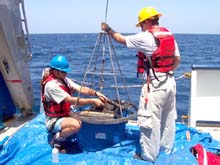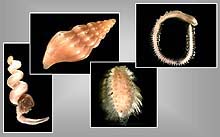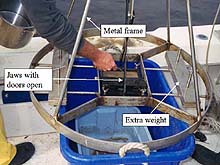
Scientist JD Dubick (left) with teacher Marty Ball (right) preparing the Young Grab for deployment. Click image for larger view.
The Young Grab
August 04, 2002
Cindy Cooksey, Marine Biologist
NOAA Ocean Service
We have had another successful day of submersible operations, but in between dives we are still busy conducting work from the deck of the R/V Seward Johnson. At each station, including Georgetown Hole where we are today, we use a Young Grab to provide material for the analysis of chemical contaminants, organic matter, and the type of sediment (e.g., percentage of sand, silt and clay). There are many types of bottom grabs currently used to sample the sediment at the bottom of the ocean. What type of grab is chosen for any particular study depends upon the interests of the scientists, the type of habitat, how much sediment is needed, and how the grab can be deployed. The Young Grab is a versatile type of bottom grab that can be used in many different habitats and deployed from both small and large research vessels.

Examples of animals that can be found living in the sandy sediments near rocky reefs. Click image for larger view.
The Sand Beneath the Waves
eople may wonder why scientists want to study the seemingly ‘barren’ sand layer that covers vast stretches of the ocean floor. One good reason is because this important habitat is not barren at all! The unconsolidated (loose) bottom that occupies the majority of the sea floor can be teeming with life. The types of animals found can include polychaete worms, molluscs, crustaceans and fish. Some are large enough to see with the naked eye, but many are so small that you would need to use a microscope to see them. These bottom-dwelling (infaunal) organisms play vital ecological roles in the decomposition of organic matter, nutrient cycling, and as prey to higher trophic levels.
The important role of the infauna is most apparent around rocky outcrops or reef structures found in the open ocean. Many varieties of fish congregate around deep-water reefs, and the infauna can be an important source of food. Certain types of fish, especially juveniles, will leave the shelter of the rocky outcrops and go foraging out over the open sand, feeding upon the animals that they find.
Because almost everything that washes out to sea will eventually settle to the ocean floor, this type of habitat also is an important place to look for potential human impacts, such as the presence of chemical contaminants (e.g., metals, pesticides and PCBs). Although we do not expect to find any high levels of chemical contamination and other human-related stressors in these offshore locations, it is important to establish a baseline of information so that in the future, we will be able to tell whether amounts of pollutants in our oceans are changing.

Closeup of a Young Grab as the top layer of sediment is scooped off to be analyzed for chemical contaminants, organic matter, and the type of sediment (e.g., percentage of sand, silt, and clay). Click image for larger view.
How the Young Grab Works
The Young Grab consists of a set of jaws that can grab a chunk of sediment from the seafloor with a surface area of approximately 0.04 square meters and to a depth of 10 cm. The jaws are set within a metal frame and weighted, which ensures the grab will not land on its side when it reaches the bottom. When the grab is deployed from the ship, the jaws are open. As it hits the bottom, its triggering mechanism releases. And as the ship pulls the grab up, the jaws dig into the sediment.
Once the Young Grab is back on deck with its bite of the ocean floor, we can open up the doors on top of the grab to glimpse a small section of ocean life. The sample is good if sediment fills the grab and has not washed out of the top. The doors on top of the jaws not only allow us the chance to evaluate the sample, but also allow us to scoop off the top layer, take a small core, or decide to keep the whole grab, depending on what is being studied.
Sign up for the Ocean Explorer E-mail Update List.














































